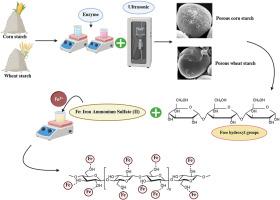Iron fortification using porous corn and wheat starches prepared by combined ultrasound and α-amylase treatments
IF 6.6
1区 农林科学
Q1 FOOD SCIENCE & TECHNOLOGY
引用次数: 0
Abstract
This study reports the fabrication of porous starches (PS) through a combined ultrasound–enzyme approach to improve iron adsorption via controlled micro-porosity and structural rearrangement. Corn and wheat starches were treated with ultrasound at 150 W (3600 s), 250 W (2400 s), and 350 W (600 s) in the presence of α-amylase (1 g/L). The resulting PS samples were characterized for water, oil, and methyl violet adsorption, while SEM and XRD analyses confirmed morphological and crystalline modifications. For iron fortification, PS samples were loaded with iron ammonium sulfate (II) (40–80 mg/L), and uptake was quantified using ICP-OES. Corn PS displayed well-developed and uniformly distributed pores, a crystallinity of 0.4709, and significantly higher adsorption capacities for water (0.6122 g/g), oil (0.3645 g/g), and methyl violet (0.7476 g/g) compared with wheat PS (crystallinity 0.5593). Maximum iron incorporation reached ∼190 mg/kg in both corn and wheat PS, though the relative improvement was greater for corn. The optimized condition (350 W, 600 s) offered high efficiency and low energy demand, highlighting corn PS as a promising, cost-effective carrier for iron fortification with potential applications in food, pharmaceutical, and cosmetic formulations.

超声和α-淀粉酶联合处理制备的多孔玉米和小麦淀粉强化铁
本研究报道了超声-酶联合制备多孔淀粉(PS)的方法,通过控制微孔隙度和结构重排来改善铁的吸附。在α-淀粉酶(1 g/L)存在下,分别在150 W (3600 s)、250 W (2400 s)和350 W (600 s)下对玉米和小麦淀粉进行超声处理。PS样品对水、油和甲基紫的吸附进行了表征,SEM和XRD分析证实了形貌和晶体修饰。在铁强化方面,PS样品加载硫酸铁铵(II) (40-80 mg/L),并使用ICP-OES定量吸收。玉米PS孔隙发育均匀,结晶度为0.4709,对水(0.6122 g/g)、油(0.3645 g/g)和甲基紫(0.7476 g/g)的吸附能力显著高于小麦PS(结晶度0.5593)。玉米和小麦PS的最大铁掺入量均达到~ 190 mg/kg,但玉米的相对改善更大。优化后的条件(350 W, 600 s)具有高效率和低能量需求,表明玉米PS是一种有前途的、具有成本效益的铁强化载体,在食品、制药和化妆品配方中具有潜在的应用前景。
本文章由计算机程序翻译,如有差异,请以英文原文为准。
求助全文
约1分钟内获得全文
求助全文
来源期刊

LWT - Food Science and Technology
工程技术-食品科技
CiteScore
11.80
自引率
6.70%
发文量
1724
审稿时长
65 days
期刊介绍:
LWT - Food Science and Technology is an international journal that publishes innovative papers in the fields of food chemistry, biochemistry, microbiology, technology and nutrition. The work described should be innovative either in the approach or in the methods used. The significance of the results either for the science community or for the food industry must also be specified. Contributions written in English are welcomed in the form of review articles, short reviews, research papers, and research notes. Papers featuring animal trials and cell cultures are outside the scope of the journal and will not be considered for publication.
 求助内容:
求助内容: 应助结果提醒方式:
应助结果提醒方式:


